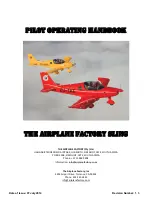
48
49
DEScENT TEcHNIQUES
The JOIN’T2 MaNUal is not a textbook for learning how to paraglide.
According to the local rules and regulations, instruction and training must be carried
out in licensed schools. The following information enables you to get the most out of
your skywalk JOIN’T2 .
SPIRal DIvE
You can initiate the spiral dive by carefully increasing the pull on one of the brakes and
simultaneously shifting your weight to the inside of the turn. If the glider doesn’t bank
up and the sink rate doesn’t increase, then stop and try again. Don’t just apply more
and more brake without sensitivity.
The skywalk JOIN’T2 enters the spiral dive with a high bank angle and makes a fast
steep turn. You control the banking and sink rate by controlled pull or release of the in-
side brake line. Light outside brake can counteract the collapse of the inside wing sec-
tion during a steep spiral dive. The spiral dive is the fastest way to lose altitude.
caUTION
The high sink rate causes high physical strain due to the increasing
centrifugal forces and may cause blackouts! - above all, please think of the
passenger -
Tensing the stomach muscles during the spiral dive can be helpful. At the first signs of
dizziness or feeling faint exit the spiral dive immediately.
Because of the extreme loss of altitude during a spiral dive always ensure you have
enough height above ground. To avoid a strong surge when exiting the spiral dive, you
have to release the inside brake while applying the outer brake slightly.
The skywalk JOIN’T2 has no tendency for locking into a spiral dive. In case it keeps on
turning under unfavourable circumstances (e.g. unintended asymmetry of the cross
brace harness) you will have to actively finish the spiral dive. In this case shift your
weight to the outside of the turn and simultaneously apply more outside brake.
Applying both brakes will also take the paraglider out of the spiral dive but the glider
can front tuck and you should dampen the exit with the brakes.
Remember: compared to regular flight manoeuvres the steering forces in a
spiral dive are a lot higher!
BIG EaRS
In contrast to the spiral dive and B-line stall, Big Ears result in an increase of forward
speed in relation to the gliders sink rate. Big Ears is used to avoid or exit dangerous ar-
eas in a horizontal direction.
EXaMPlE
>In strong winds or below a thundercloud at low altitude it is possible that neither B-
line stall or spiral dive will help. Big Ears are the easy way out.
>If the pilot is stuck in strong lift and needs to look for sink it is advisable to exit the
lift band with the use of Big Ears..
In order to fold the wing tips you have to pull both outer A-risers simultaneously. This
will cause both wing tips to fold inwards and the skywalk JOIN’T2 will enter a stable for-
ward flight.
The brake handles remain in your hands together with the outer A-risers. Braking and
weight shift enables you to steer your paraglider.
In order to increase the sink and forward speed you can optimise this manoeuvre by us-
ing the acceleration-system. The risk of canopy destabilisation in turbulent air is clearly
reduced when using Big Ears.
To exit Big Ears release the A-lines. The canopy will unfold automatically. You may brake
a little to support the unfolding. It is advisable to pump out one side at a time to reduce
the risk of detaching airflow.
B-lINE STall
A tandem B-line stall requires a high expenditure of energy and is therefore not carried
out as comfortably as with a solo glider. Because of the increased wear and tear to the
material, we do not recommend performing the B-line stall as an aid to descent.
For rapid descents you should choose between spiralling and making ears, depending
on the situation.
all DEScENT TEcHNIQUES SHOUlD BE TRaINED IN calM aIR aND WITH
SUFFIcIENT alTITUDE BEFORE USING THEM IN EMERGENcY SITUaTIONS
aND IN TURBUlENT aIR.
Summary of Contents for JOIN'T 2
Page 1: ...Seriennr Handbuch Serviceheft JOIN TOGETHER...
Page 15: ...28 29 Tragegurt Notizen...
Page 31: ...60 61 Riser Notes...


































